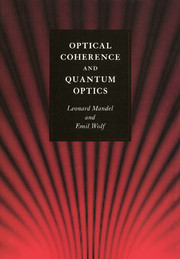Book contents
- Frontmatter
- Contents
- Preface
- 1 Elements of probability theory
- 2 Random (or stochastic) processes
- 3 Some useful mathematical techniques
- 4 Second-order coherence theory of scalar wavefields
- 5 Radiation from sources of any state of coherence
- 6 Second-order coherence theory of vector electromagnetic fields
- 7 Some applications of second-order coherence theory
- 8 Higher-order correlations in optical fields
- 9 Semiclassical theory of photoelectric detection of light
- 10 Quantization of the free electromagnetic field
- 11 Coherent states of the electromagnetic field
- 12 Quantum correlations and photon statistics
- 13 Radiation from thermal equilibrium sources
- 14 Quantum theory of photoelectric detection of light
- 15 Interaction between light and a two-level atom
- 16 Collective atomic interactions
- 17 Some general techniques for treating interacting systems
- 18 The single-mode laser
- 19 The two-mode ring laser
- 20 The linear light amplifier
- 21 Squeezed states of light
- 22 Some quantum effects in nonlinear optics
- References
- Author index
- Subject index
15 - Interaction between light and a two-level atom
Published online by Cambridge University Press: 05 April 2013
- Frontmatter
- Contents
- Preface
- 1 Elements of probability theory
- 2 Random (or stochastic) processes
- 3 Some useful mathematical techniques
- 4 Second-order coherence theory of scalar wavefields
- 5 Radiation from sources of any state of coherence
- 6 Second-order coherence theory of vector electromagnetic fields
- 7 Some applications of second-order coherence theory
- 8 Higher-order correlations in optical fields
- 9 Semiclassical theory of photoelectric detection of light
- 10 Quantization of the free electromagnetic field
- 11 Coherent states of the electromagnetic field
- 12 Quantum correlations and photon statistics
- 13 Radiation from thermal equilibrium sources
- 14 Quantum theory of photoelectric detection of light
- 15 Interaction between light and a two-level atom
- 16 Collective atomic interactions
- 17 Some general techniques for treating interacting systems
- 18 The single-mode laser
- 19 The two-mode ring laser
- 20 The linear light amplifier
- 21 Squeezed states of light
- 22 Some quantum effects in nonlinear optics
- References
- Author index
- Subject index
Summary
Light is both radiated and absorbed by atoms, and the interaction between the quantized electromagnetic field and an atom represents one of the most fundamental problems in quantum optics. However, real atoms are complicated systems, and even the simplest real atom, the hydrogen atom, has a non-trivial energy level structure. It is therefore often necessary or desirable to approximate the behavior of a real atom by that of a much simpler quantum system. For many purposes only two atomic energy levels play a significant role in the interaction with the electromagnetic field, so that it has become customary in many theoretical treatments to represent the atom by a quantum system with only two energy eigenstates. This is the most basic of all quantum systems, and it generally simplifies the treatment substantially.
In a real atom the selection rules limit the allowed transitions between states, so that, in some cases, a certain state may couple to only one other. Moreover, optical pumping techniques have been developed that allow such preferred states to be prepared in the laboratory, and they have been successfully used in experiments (Abate, 1974). The two-level atom approximation is therefore close to the truth and not merely a mathematical convenience in some experimental situations. In the following we begin by developing the algebra for such a two-level atom.
Dynamical variables for a two-level atom
We consider an atomic quantum system with the two energy levels shown in Fig. 15.1.
- Type
- Chapter
- Information
- Optical Coherence and Quantum Optics , pp. 741 - 804Publisher: Cambridge University PressPrint publication year: 1995



